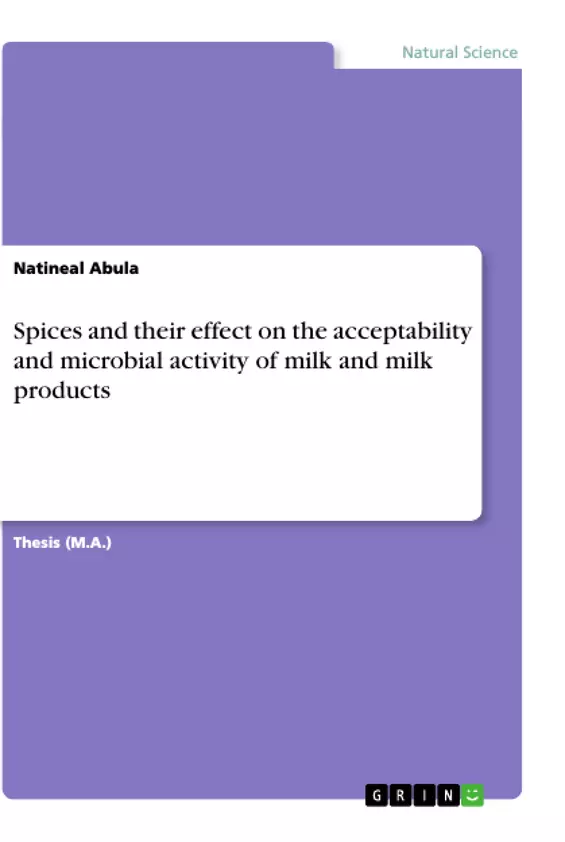Spices have been used by human being for thousands of years having multipurpose functional roles such as medicinal use, preservation of food, improving the flavor and aroma of foods. This is also widely used in Ethiopian dairy products. This study was conducted in Tambaro woreda and Hosanna district to assess the traditional practices, types of spices and herbs used in preserving various dairy products in the study area. It was also used to identify the effect of spices on cottage cheese (ayib) and ghee microbial activities and acceptability under controlled laboratory experiments.
The study also explored the potential implications of spice uses towards the sensory properties of these dairy products. The experimental study was conducted as a follow-up to diagnostic survey. The cottage cheese were randomly assigned to either of three spice treatments Kororima and Tikur azimud, or Kororima and Netch azimud mixtures (equal ratio) at 0, 1, 3 and 5% levels by weight concentration, respectively. The ghee samples were randomly assigned to either of four spice treatments Kororima and Abish, or Tikur azimud and Netch azimud mixtures (equal ratio) at 0, 1, 3 and 5% levels by weight concentration, respectively.
Cottage cheese samples were stored for 6 days and ghee samples for 30 days at ambient temperature before parameter analysis. Cottage cheese samples were analysed every 24 hrs, while the ghee samples were analysed once in a week for compositional, microbial and sensory properties, which included total solids, ash, fat content, pH, total bacterial count, coliform, and yeast and mould counts. The sensory analysis included flaver, aroma, taste and overall acceptability of ghee and cottage cheese samples.
Data was analyzed using SPSS 16.The experimental study highlighted that cottage cheese samples treated with 3% of Korrorima and Netch azimud mixtures received the highest acceptability and lower YAM count(5.746cfu/g) and Coliform counts(1.792 cfu/g). The mean microbial load is higher on control sample (6.40 cfu/g YAM and 1.95cfu/g Coliform counts). Coli forms were absent in all ghee samples. Ghee sample treated with 5% of Kororrima and Abish mixtures revealed relatively higher overall acceptability. Usage of natural extract of spices and herbs is safe and promising option for consumer preference, preservation and shelf life extension of the dairy products.
Inhaltsverzeichnis (Table of Contents)
- DEDICATION
- ACKNOWLEDGEMENT
- TABLE OF CONTENTS
- ABBREVIATIONS AND ACRONYMS
- LIST OF TABLES
- LIST OF FIGURES
- LIST OF TABLES IN THE APPENDIX
- ABSTRACT
- 1. INTRODUCTION
- 1.1. Background and Justification
- 1.2. Statement of the Problem
- 1.3. Research Objectives
- 1.4. Significance and Scope of the Study
- 2. LITERATURE REVIEW
- 2.1 Dairy Production in Ethiopia
- 2.2. Handling Practices of Milk and Milk Products in Ethiopia
- 2.3. Factors that Affect Storage Quality of Dairy Products
- 2.4. Functional Properties of Spices and Herbs
- 2.5. Spoilage Microorganisms of Dairy Products
- 2.6. Microbial Quality of Ayib and Ghee
- 2.7. Physico-chemical Properties of Ayib and Ghee
- 2.8. Consumer Acceptability of Dairy Product
- 2.9. Spices Used in Ayib and Ghee Production Process in Ethiopia
- 2.10. Consumption of Milk and Milk Products in Ethiopia
- 3. MATERIALS AND METHODS
- 3.1. Description of the Study Area
- 3.2. Study Design
- 3.2.1. Survey
- 3.3. Laboratory experiment
- 3.3.1. Preparation of Spice powder
- 3.3.2. Preparation of Ayib
- 3.3.3. Preparation of Ghee Sample
- 3.5. Treatment arrangement
Zielsetzung und Themenschwerpunkte (Objectives and Key Themes)
This thesis aims to investigate the effect of spices on the microbial activity and acceptability of milk and milk products, specifically Ayib and Ghee, in Ethiopia. The study explores the impact of different spices on the growth of spoilage microorganisms and the sensory properties of these dairy products. The research seeks to identify the optimal spice combinations for improving the shelf-life and palatability of Ayib and Ghee, contributing to better dairy product quality and consumer satisfaction.
- The influence of spices on microbial growth and spoilage in Ayib and Ghee
- The impact of spices on the sensory characteristics of Ayib and Ghee
- The identification of optimal spice combinations for enhancing the shelf-life of Ayib and Ghee
- The investigation of the consumer acceptability of Ayib and Ghee incorporating various spices
- The assessment of the potential of spices as natural preservatives in milk and milk products
Zusammenfassung der Kapitel (Chapter Summaries)
- Chapter 1: Introduction This chapter establishes the background and justification for the study, outlining the significance of milk and milk products in Ethiopia and the challenges associated with their quality and shelf-life. It also presents the research objectives and the scope of the study.
- Chapter 2: Literature Review This chapter provides a comprehensive review of existing literature related to dairy production, handling practices, and factors affecting the quality of milk and milk products in Ethiopia. It also explores the functional properties of spices, the microbial spoilage of dairy products, and the physico-chemical properties of Ayib and Ghee. Furthermore, it examines consumer acceptability of dairy products and the consumption patterns of milk and milk products in Ethiopia.
- Chapter 3: Materials and Methods This chapter details the materials and methods used in the study. It describes the study area, the study design, and the procedures for preparing spice powders, Ayib, and Ghee samples. It also outlines the experimental treatments and data collection methods.
Schlüsselwörter (Keywords)
The key terms and concepts explored in this thesis include spices, microbial activity, Ayib, Ghee, dairy products, shelf-life, consumer acceptability, sensory properties, spoilage microorganisms, and natural preservatives.
- Quote paper
- Natineal Abula (Author), 2018, Spices and their effect on the acceptability and microbial activity of milk and milk products, Munich, GRIN Verlag, https://www.grin.com/document/514358



